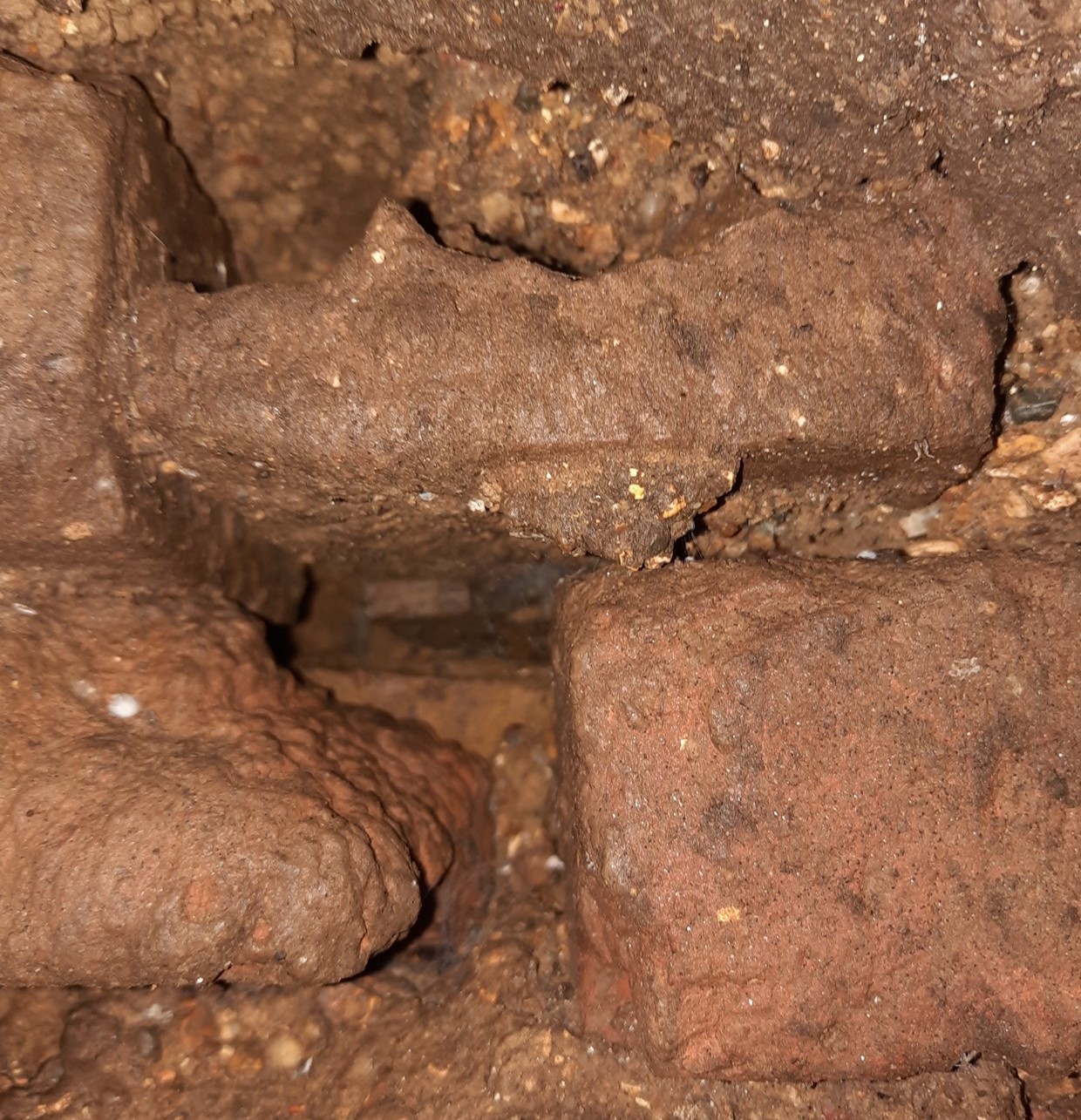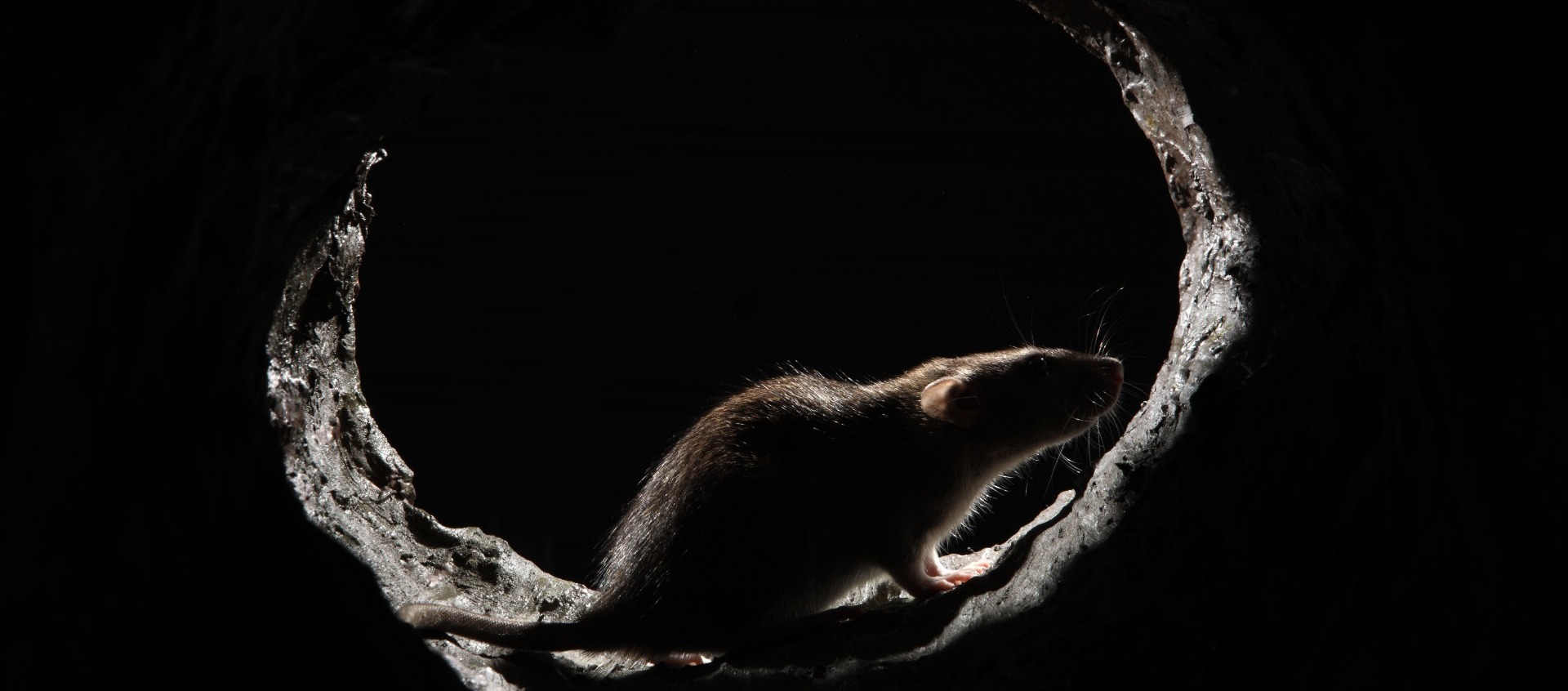Rats and drains – the perfect combination
Posted on 16th January 2022 at 10:06
When we get the call for a job involving any internal problem with rats, we start by conducting an extensive survey of the property which includes any adjoining parts of the ‘structure’ when it comes to rats you have to see the whole picture, so we include any properties attached to the one which we’ve been called out to. Rats are without doubt the biggest pest in numbers that we deal with, and we carry out more rat control in Maidenhead than anything else and that includes all the insect pests we deal with.
Rats in Maidenhead
When it comes to the rat treatment, we look for the glaringly obvious things like a bad joint where the mortar has slipped out, or a gnawed open air brick and the ubiquitous pipe hole that was left over from when the new kitchen was installed. But there is one fact that we can’t escape when looking at rat problems and this is that about 70% of internal rat infestations stem from a fault under the house in the main drainage.
Throwing rat poison at the problem in a situation like this just isn’t the solution, you need to strip the layers back and understand the narrative and the only way to do that is to look inside the drains.
So what lies beneath your home?

Types of drains
There are two different types of drainage system: one that connects your house and every other house in the street to the main, water companies sewer in the street outside, and the other one which only serves one property at a time and is a series of tanks that settle the solid waste from the liquid (99.9% of domestic sewerage is just water) and allow to drain away into the surrounding ground – these are termed cesspits or septic tanks and usually found on rural properties.
The first system mentioned commonly has rats running around inside; they don’t actually live inside these drains as the pipes are quite narrow and there are few dry areas for them to nest in, but they do act as an easy route for rats to move around the streets of our towns and cities undetected. On the plus side for rats, as well as easy movement, these drains are full of food, and they have plenty of water. Combined with that, the ambient temperature in the drains, is about 5 degrees higher than the temperature outside, so handy in the winter.
It’s generally the drainage system that connects up to the main sewers where we find the most problems due to the scale of the system and the sheer amount of defects that occur along its length; rats ill not live in these drains but faults and open manholes allow them to slip inside and from there, they will explore the system and if there are faults near, or underneath your property, then the chances are you will have a rat problem inside your home and I’ll explain why in this blog.

The super skills of rats
To fully appreciate how problems with drains leads to infestations inside let’s explain that rats have three major skill sets that make them our Number 1 pest in Maidenhead.
Their first super skill is that they are resourceful scavengers and rats will sniff out every crack and cranny seeking any opportunity for food or shelter, we often find that the brickwork of older drain inspection pits where rats have spent years and years, gnawing away at an edge on the exposed bricks and squeezing through the gap created to get inside.
Secondly, rats are incredibly intelligent animals, put a rat inside a maze and it’ll figure out the route through and remember it in no time at all. We have seen rats enter via the drains at one house in a series of link detached properties (these are the houses that although they are detached from one another, they all have a garage linking them between), in this case we saw rats come in and travel through the first garage, through the next house and next garage into our customer’s house.
The third of our super skills goes to the fact that rats can slip through the space of a modern fifty pence piece; in today’s modern construction and the speed in which houses get built do you really think that gaps of that size aren’t noticed?
We’ll see a wide range of building defects that you wouldn’t even look twice at, which have let rats through into the interior of a building. Rats are determined, clever and highly capable so when rats are in the drainage system outside your home, it’s a given that they are working on getting inside.

Rats and drains the perfect combination
Suitably equipped with a range of super skills, any defect in the drainage system is going to be exploited by these animals and you will find yourself with rats running through the loft and cavity walls and we’ll explain why this happens.
When the drains enter the property, they generally pass through the outside wall, in effect they punch through underground and you have a point of access alongside the pipe as it passes through the cavity wall, this entrance leads up the inside of the walls and into the loft. The easy way to find where you’re pipes run is to look for a hollow vertical box somewhere in the kitchen or utility room, alternatively look at the roof and see if a pipe protrudes through the tiles – this is the stack pipe or soil vent pipe that connects the house to the outside drain.
The common problems we see with drains fall into three categories and these are:

Faults in inspection pits
Any waste system should be fitted with one or more inspection pits outside the footprint of the property; this is where all of the separate lateral drains of the buildings’ system come together before joining up and running off to the main sewer. Some houses may have a single stack pipe where the waste pipes from the kitchen, bathroom and toilet all connect up before leaving the structure so you get a single inspection pit, other properties may have multiple stack pipes because the layout of the drains is spread over a wider area and usually these all congregate to one or two larger pits before running off to join the sewer.
No matter which system you have, you should have an inspection pit that ideally sits outside of the building’s boundary; commonly we find problems where rear aspect extensions are built over the top of these pits because the builder either wanted an easier job or just didn’t understand what he was doing.
Unfortunately building over pits happens far too often and this creates major issues for homeowners when things go wrong. Usually, we find that the drain layout has been changed and because the builder was happy to ‘cut corners’, problems arise from poor workmanship and there is no access into the inspection pit or the drains. Situations like this lead to unfettered access for rats and means that major works, such as digging through the floor of the extension will be needed to rectify the issue.
Faults in inspection pits that are access points for rats are one of the most likely scenario’s that we deal with, and these can range from simple faults such as precast concrete sections of the pit walls sinking, in doing so they leave a gap between the topmost ring and the cast concrete lid enclosure. When this happens, rats will simply climb up the inner face of the pit, through the gap and over the top and then follow the line of pipework into the property.
Other faults that can happen in older pits with brick walls, is where the brickwork has either crumbled away or the mortar joints have fallen out allowing a gap to appear which will be gnawed at by generations of rats; these animals will gnaw away at the sharp edge of the brick until there is a space big enough to squeeze through and into the void on the other side. Modern inspection pits are often made of plastic, and these will be attacked by rats and they will gnaw on any edge that they can; in fact, all modern drainage is plastic, and the sharp teeth of rats make short work of getting inside, especially where a joint has not been formed properly.
Some of the old inspection pits have a vent pipe that connects the pit to the outside atmosphere; where these are fitted you can see a cast iron snorkel that sits just above ground level. These vents are typically found in older, period properties when the owners didn’t need to make provision for cars; as the properties have been modernised and driveways put in, these snorkels have been taken out. When this happens, if the opening on the side of the pit hasn’t been sealed, rats will dig their way out from the drain, and we can find them climbing into nearby vehicle engine bays and causing damage to wiring and plastics.
Another common fault that we find is where alterations have been done to a house and one or more of the laterally running drains has been taken out of use and then incorrectly capped off by the builder. All too often we see plastic rubbish bags, rubble, or expanding foam used to block a redundant section. In the worst cases we’ve seen open ends of drainage pipes that simply terminate under floorboards – this is not the correct way to seal a drain and will undoubtably lead to issues in time with smells, flies and of course – rats.

Faults in the vertical stack
When looking at the waste water system of your house think in terms of a tree; the vertical part is the soil vent pipe or stack pipe as its often called, and this runs either through the roof of the property to vent into open air or somewhere inside where a one way air admittance valve or ‘durgo’ as it’s called, sits on the top.
Rats are extremely capable climbers and they can easily scale the inside of a stack pipe and it doesn’t matter whether its made from plastic or cast iron, never underestimate the ability of rats to climb as we’ve had rats swimming around in the toilet pan on the second floor of a house fitted with modern plastic pipe.
Faults can occur in the stack pipe starting at the bottom with the resting bend; this is a curved piece of the pipework that sits at the junction between the horizontal pipe and the vertical. The ground that your home sits on is constantly moving, either very gradually over many years and at other times quite quickly and the resting bend is under strain due to the downward force applied to the immovable horizontal object.
We tend to see more faults in vitrified clay pipes as although strong in compression, the clay is weak in tension, and the strain on the pipe causes it to break open. Any break will be exploited by rats which will burrow through the soil and find a way inside where the pipes cut through the cavity wall.
Other faults can simply be due to a change in material from cast iron to clay; the use of plastic collars to join the different materials or years of corrosion on iron pipework can degrade the stack enough that a hole is formed, which is big enough for rats to slip out of. These sorts of faults can be difficult to detect by camera, and we can use a smoke generator to pump an odourless smoke into the system; if we can seal the top of the stack this will pressurise the pipework allowing us to see the smoke filter through the defect into the house.
The usual course of the stack pipe is to end up, poking out of the roof of the property and occasionally we see an internal rat infestation which has been caused by rats climbing up the inside of the pipe, emerging onto the roof and then slipping inside through a gap in the roof tiles. Faults like this are easily by fitting a metal wire balloon and yet common enough that we’ll see at least one of these types of job every year.
Where durgo valves are fitted, these are housed internally and often found inside the loft, a false wall, or a section of boxing. Being constructed from plastic and easily gnawed through by rats, we do sometimes find these valves to be the reason for an internal infestation and very problematic. It often involves cutting open walls or removing tiles from box sections in bathrooms.

Faults in the underground pipework
Lastly we find problems in the underground section of the drainage system and depending on the age of your property, it will have either have clay or plastic pipes and these pipes are prone to accidental damage and collapse. Damage comes in the form of something like a fence post punching through the top of the pipe, we’ve also seen gas mains that punch straight through redundant clay pipes that were once properly sealed but now are the exit point for rats.
Do rats dig? Yes they do and that’s one of their primary ways of moving around, rats in the wild live underground and they are efficient diggers and can dig down far enough to get under foundations of older properties or to find the build overs that allow the pipes to pass through the cavity wall. When you have drains that maybe a metre underground then they already have a head start.
The older clay pipes are prone to collapse where the ground is settling; in Woodley, the airfield estate was built on old ground that had been worked for gravel extraction. The ground was heavily landscaped to level it out in the 1980’s, this ground is now compressing and we see a great deal of broken clay pipes that allow rats to escape and gain access into the interior.
Not all drain faults are the responsibility of the homeowner, depending where the fault is, it may mean that any expensive repairs falls to the local water authority; just because the drains on your property, it doesn’t mean that its yours to maintain.
The website draindomain.com shows you which parts of the system belong to the individual houses and which the local water company own and maintain; you can ask for a drain survey from the water company if you suspect a problem with the drains.
Water Authorities will provide a free survey, but this will only be concentrated on their particular section of the system and our experience from these inspections is that often they report back findings that show there are no problems and no signs of rats which confuses the issue. A free survey is a good starting place because any faults in the shared system will be fixed by the water authority and at no cost to yourself.
Our experience of surveying drains is that rats don’t leave calling cards, and we often see no trace of them but after applying tracking dust to the drains for a period of time we can tell if they have been through and so determine whether or not the fault does lie within the drainage system.
If you need a professional drain survey, then its best to make sure the company carrying out the inspection are members of the National Association of Drainage Contractors; as members they work to a high standard and a set code of conduct, reports are produced to a professional level and not like the ‘back of a fag packet sketches’ that we’ve seen before. We had a customer in Wokingham who chose a local company to carry out just the survey and ended up calling the police to get them to leave her property; this was after they’d put in a portable toilet (at her expense) and dug up her entire patio and driveway to replace all of the undamaged plastic pipe.
Any drain survey should include a typed up report with time and date stamped photos of defects or a live recording of the survey, another scam we came across was a company in Reading who carryout surveys and show the customer stored footage of defects from the cameras memory and then bill them for work that doesn’t exist and doesn’t actually get done.

One way valves or rat flaps
the latest craze for dealing with rats in drains – selling one way valves as a ‘cure’ for a drain defect, these valves can be either metal or plastic and the idea is that they are inserted into the outlet of the faulty section and act to prevent the passage of rats going against a hinged flap.
Plastic valves? We’ve already said that plastic is no deterrent against the teeth of rats so why anyone would buy and fit a plastic valve is beyond me but they’re for sale on the internet at all sorts of prices, the metal ones work, sometimes to a limited degree and can be fitted as a way of giving a customer thinking time. Any drain repair is going to be expensive and generally when it includes a survey, the cost is around £1000 and upwards, we’ve seen repairs which stretch into tens of thousands but this was a main sewer that had collapsed under an extension of a house in Windsor and the cost was borne by Thames Water, thankfully.
Drain valves can fail by sticking open and with costs from a reasonable one at £60 to an eyewatering £230 (for basically the same thing) our advice is to assess the need first, remember that one day you may sell the property and not notifying the new buyer of a major fault with the drains may have repercussions!
Here at Maidenhead Pest Control we never charge for our drain surveys – the reason for this is that we are not qualified to deliver what is a complex service that needs to be able to assess 100% of the system, secondly, our goal is to deliver the best possible service that we can. The drain surveys that we carryout are all part of our determination to get you rat free and the photos on this blog are those taken from our camera where we have pinpointed the reason for a customer’s rat problem, often this is within an hour of attending the job.
Here at Maidenhead Pest Control our customers are our priority and when it comes to rat control we look at the bigger picture to get the job done.

Tagged as: Rats
Share this post:















